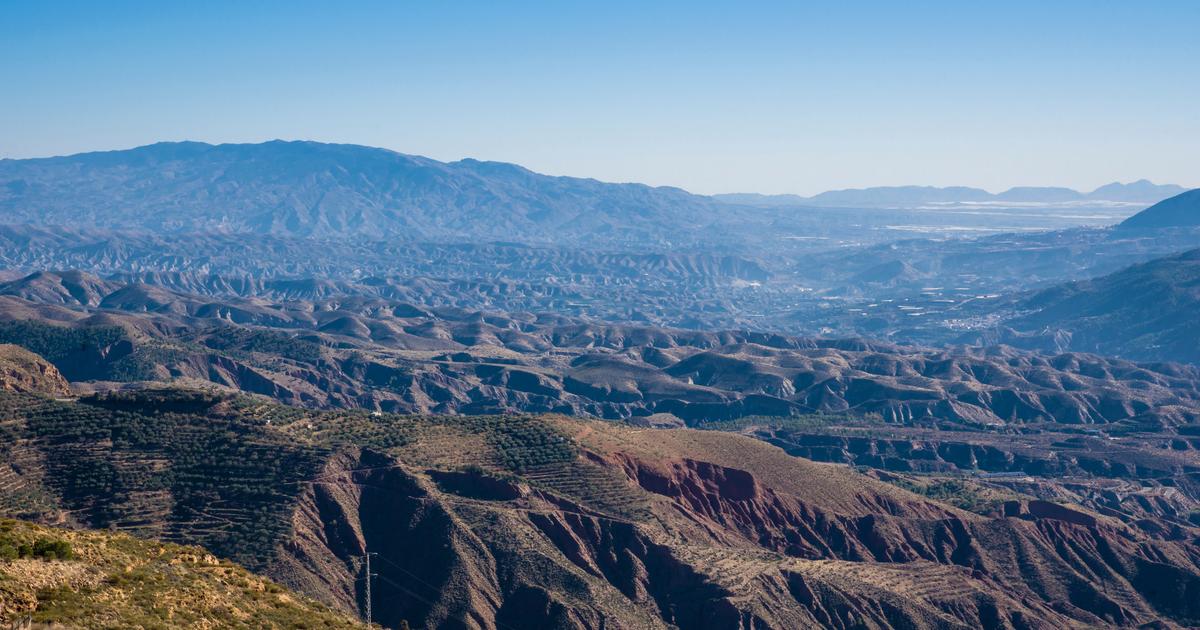Some rusty stairs that go nowhere.
Years ago they flowed into the beach, but not anymore.
Where before there was sand, now there is a wall of rocks that contains the waves.
A few meters from the rocks, the roar of a train is heard as it stops in the Barcelona municipality of Premià de Mar, with a population of 28,000.
Near the station, on the seafront, some gaps show the ravages of a recent storm.
It's more than a few glitches.
These are the scars caused by climate change to the emblematic R1 Cercanías line (Molins de Rei-Massanes), heir to the first railway in Spain (Barcelona-Mataró), today threatened by rising sea levels, warn geologists and reports from the Generalitat of Catalonia.
Along its 50 kilometers of coastline north of Barcelona, on the Maresme coast, there are 16 municipalities inhabited by nearly half a million residents, 37 beaches and five marinas with hundreds of boats.
On a weekday, around 100,000 people on average take a train somewhere in this territory cloistered between a mountain range and the Mediterranean.
Some of its municipalities, such as Premià or Vilasar de Mar, were built around streams that flow into the sea.
The railway line is the most used in Catalonia and one of the main arteries to access Barcelona without a car.
From a bird's eye view, the railway structure looks like a kilometric border.
A giant zipper made up of two-way cables and tracks that has separated the urban center from the beach for 174 years.
The residents of the municipalities have to go through underground tunnels, with the appearance of war bunkers, to access the sea.
And what they find is a very languid coastline that loses 3.3 centimeters every decade, according to data from the Meteorological Service of Catalonia.
“You have to rethink everything.
Nature does its job and climate change is accelerating it.
We have a local responsibility to assume the way in which we have built”, explains the director of the GeoRisc Observatory, of the College of Geologists of Catalonia, Joan Manuel Vilaplana.
The poor urban planning of the Catalan coast has led to 60% being urbanized in its first 100 meters, according to a report presented by the Generalitat last September.
In this document, the Executive admits that poor planning has taken the coastline "to the limit" and among the biggest problems it points out precisely this great infrastructure, whose route, it affirms, will be necessary to move "in the medium term".
Sources from the Ministry of Transport, Mobility and Urban Agenda explain, however, that "at the moment" this action is not being considered.
The Generalitat report also warns of the investments that are already involved in mitigating the effects of climate change on the coast.
There are clear signs.
In 2020, Adif (Administrador de Infraestructuras Ferroviarias), owner of the infrastructure, announced an investment of 12 million to repair and adapt a 2.2-kilometre section due to the damage caused by storm
Gloria,
which hit with waves of up to four meters .
The Government of Spain, competent in coasts, strives to contain the bleeding of sand.
The Ministry for the Ecological Transition and the Demographic Challenge presented a project in 2014 for the restoration of the beaches in order to dredge tons of sand and manufacture more breakwaters that help preserve the coastline.
"We can resist a
Gloria,
but not two," says Vilaplana, who defines these actions as "temporary patches" that do not take into account the approaching scenario.
Adif sources add to this newspaper that the company's intention is to extend the repairs and adjustments throughout the entire route, and that if it was decided to start with this section it was because it was where there were more problems.
"Since then there have been no incidents," these sources defend.
The line, however, accumulates complaints from users, who denounce constant delays.
"Today, a train 30 minutes late," Antoni Esteban, spokesman for the Preservem el Maresme movement, a platform of neighbors and entities that ask for solutions, complained last week.
“Experts agree that the sea will flood the stations in decades.
Knowing this, why not at least begin to study the feasibility of a new route?
We have to think about tomorrow”, defends Esteban.
For Vilaplana, the most responsible option, even if it is multimillionaire, is moving the journey inland.
A proposal that some city councils were already demanding at the beginning of the century and that was reactivated after the serious storm of 2020. "It would mean a lot of money, but the State has to be brave", defends the Town Planning Councilor of the Vilasar de Mar City Council, Àngel Font , who also warns that the drainage to keep sand on the beaches is not enough.
More information
We are not doing something right
The mayor of Mataró, the socialist David Bote, explains that "in the medium and long term" the solution lies in some way in moving the line.
And in the short term, for managing to pacify the adjoining N-II highway, a road that until a few months ago served as an alternative line to access Barcelona without paying tolls.
After the liberalization of highway rates, the road has seen its traffic drastically decrease.
The councilor defends that this action, together with the permeabilization of the railway section in the municipality, would allow the city, as the Olympic Barcelona of the nineties did, to reconcile with the sea.
Sources close to the Minister of Transport, Raquel Sánchez, admit that the hypothetical transfer of the road "would mean a great urban improvement".
But they explain, however, that "the costs would be very high" and that the problem would persist with the affectation of other "adjacent elements".
Also that the houses that are in the first line would be affected by said transfer.
And they defend that the solution is to protect the territory by generating more beaches.
Vilapana answers: “It costs a lot for administrations to have a broad view where urban planning, mobility and sustainability are taken into account together.
We will have to do more pedagogy to convince”, says this university professor while the wind hits his face and the waves die against the jetty.
Five marinas and overdevelopment
It is no coincidence that the place chosen to build the first railway in Spain was, literally, the beach.
Inaugurated in 1848, it responded to the need to connect the industrial centers, built along the coast, with Barcelona, and facilitate their export by sea.
The road was widened;
the adjoining territory was filled with houses and in front of it, on the sea, five marinas were built.
The breakwaters cut off the currents that naturally transported the sand and the sea gained space on the beach until it literally besieged the tracks.
The images taken by an American plane in 1945 documented by the Cartographic and Geological Institute of Catalonia today serve as evidence to document the aquatic fence.
If it is compared with the current satellite images, it is clearly observed how while in some points of the coast the beach has completely disappeared, in others tons of sand accumulate around the breakwaters.
The director of the GeoRisc Observatory, Joan Manuel Vilaplana, adds another problem: over-urbanization in the streams has meant that less sediment is provided.
As well as being dangerous.
According to the Generalitat, 15% of the urbanized territory in river areas of the community is at risk of being flooded.
You can follow CLIMA Y MEDIO AMBIENTE on
and
, or sign up here to receive
our weekly newsletter
Exclusive content for subscribers
read without limits
subscribe
I'm already a subscriber

/cloudfront-eu-central-1.images.arcpublishing.com/prisa/G72BJ23PQ7FZSV232ACPO32SEE.JPG)




/cloudfront-eu-central-1.images.arcpublishing.com/prisa/NVNWO3I775MZS65U3OPMLBFLF4.jpg)





/cloudfront-eu-central-1.images.arcpublishing.com/prisa/KMEYMJKESBAZBE4MRBAM4TGHIQ.jpg)


